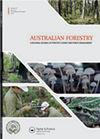How can we grow the plantation estate and improve private native forest management in Australia? Silvopastoral systems provide a solution
IF 0.9
4区 农林科学
Q3 FORESTRY
引用次数: 0
Abstract
The area of plantation forest in Australia has declined by more than 10% since 2011–12 (Whittle et al. 2019; Legg et al. 2021), with possible further losses following the 2019–20 bushfires. This is despite growing demand for wood products and their known ability to capture and store carbon. The agriculture and land-use sector has an important role to play in reducing greenhouse-gas (GHG) emissions to help meet national targets and international commitments (e.g. the Paris Agreement on climate change) and limit the increase in average global temperatures to 1.5°C. Estimates by the Australian Bureau of Agricultural Resource Economics and Sciences suggest that few or no new long-rotation hardwood plantations will be established under current policy settings and economic conditions and that high land prices preclude the establishment of new plantations on modified pasture land (Whittle et al. 2019). Although some new policy initiatives to encourage plantation investment have been announced since 2019 (e.g. the federal government’s timber plantation grants worth AUD 86 million, and the Regional Investment Corporation Plantation Loans – RICPL – scheme), it will take some years before this translates into action on the ground and to the expansion of the plantation estate. Even with large-scale new plantation investment, it will still take more than 20 years before the first small sawlogs are produced, with larger logs taking 30 years. Further, the availability of timber from public native forests has been reduced since 1990 with the creation of formal and informal reserves; by 2030, the national sustainable yield in public native forests is forecast to decline to around 38% of the level reported in the 1998 reporting period (i.e. 1992–1996; Montreal Process Implementation Group for Australia and National Forest Inventory Steering Committee 2018). So, what is the potential for increasing timber production in private native forest areas? In some regions of Australia, large areas of privately owned native forest have produced timber in the past, and some – particularly in northern Australia – are subject to livestock grazing. In 2015–16, an estimated 11.8 million ha of private native forest in Queensland and 7.2 million ha of private native forest in New South Wales (NSW) were not legally restricted from wood harvesting (Montreal Process Implementation Group for Australia and National Forest Inventory Steering Committee 2018), although these numbers overestimate the area available for timber harvesting. When considering only commercially productive forest types, Lewis et al. (2020) reported approximately 2.1 million ha of potentially harvestable private native forest in southern Queensland. From a forestry perspective, however, many of these forests are degraded and in a poor productive state. For example, Lewis et al. (2020) found that private native forests in Queensland and NSW have a high proportion of small and unmerchantable trees that are growing very slowly. Decades of high-grading – that is, the selective removal of the bestquality timber trees without follow-up silvicultural treatment – have undoubtedly contributed to the high proportion of small and unmerchantable trees at many sites (Ryan and Taylor 2006; Lewis et al. 2020). The potential of private native forests to provide timber products in the future, even with improved management, is therefore limited at present, but this is not well recognised by governments, landholders and society. In addition to their role in carbon sequestration and GHG offsets, both the plantation estate and private native forests will be crucial if Australia is to meet its growing demand for timber while reducing its international ecological footprint due to imported wood products. This is even more the case because governments have announced their intention to phase out native forest harvesting on public land in Victoria, Western Australia and South East Queensland. Several measures may be needed to ensure ongoing supplies to the domestic timber industry. Silvopastoral systems (SPSs) – in either native forests or new plantations, or both – provide one such measure that is yet to be widely adopted in Australia.我们如何在澳大利亚种植种植园并改善私人原生森林管理?Silvopastoric系统提供了一种解决方案
自2011-2012年以来,澳大利亚的人工林面积下降了10%以上(Whittle等人,2019;Legg等人,2021),2019-20年丛林大火后可能会造成进一步的损失。尽管对木制品的需求不断增长,而且已知其具有捕获和储存碳的能力,但情况依然如此。农业和土地利用部门在减少温室气体排放方面发挥着重要作用,以帮助实现国家目标和国际承诺(如气候变化《巴黎协定》),并将全球平均气温的上升限制在1.5°C以内。澳大利亚农业资源经济和科学局的估计表明在当前的政策环境和经济条件下,将建立长期轮作的硬木种植园,而高昂的土地价格阻碍了在改良牧场上建立新的种植园(Whittle等人,2019)。尽管自2019年以来,已经宣布了一些鼓励种植园投资的新政策举措(例如,联邦政府价值8600万澳元的木材种植园拨款和区域投资公司种植园贷款(RICPL)计划),但这还需要几年的时间才能转化为实际行动和种植园的扩张。即使有大规模的新种植园投资,第一批小型锯材的生产仍需要20多年,而大型锯材则需要30年。此外,自1990年以来,由于建立了正式和非正式的保护区,公共原生森林的木材供应量有所减少;到2030年,国家公共原生森林的可持续产量预计将降至1998年报告期(即1992-1996年;澳大利亚蒙特利尔进程执行小组和国家森林清单指导委员会,2018年)报告水平的38%左右。那么,在私人原生林区增加木材产量的潜力是什么呢?在澳大利亚的一些地区,过去有大片私人拥有的原生森林生产木材,有些地区——特别是在澳大利亚北部——受到牲畜放牧的影响。2015-16年,昆士兰估计有1180万公顷的私人原生森林和新南威尔士州(NSW)的720万公顷私人原生森林没有受到木材采伐的法律限制(澳大利亚蒙特利尔进程执行小组和国家森林清单指导委员会,2018年),尽管这些数字高估了可用于木材采伐的面积。当仅考虑商业生产性森林类型时,Lewis等人(2020)报告称,昆士兰南部约有210万公顷潜在可采伐的私人原生森林。然而,从林业的角度来看,这些森林中的许多已经退化,生产力低下。例如,Lewis等人(2020)发现,昆士兰和新南威尔士州的私人原生森林中,生长非常缓慢的小而难以种植的树木比例很高。几十年的高等级——也就是说,在没有后续造林处理的情况下选择性地移除最优质的木材——无疑导致了许多地点的小而不可收购的树木比例很高(Ryan和Taylor,2006;Lewis等人2020)。因此,即使管理有所改善,私人原生森林在未来提供木材产品的潜力目前也是有限的,但这并没有得到政府、土地所有者和社会的充分认可。如果澳大利亚要满足其日益增长的木材需求,同时减少进口木材产品造成的国际生态足迹,除了在碳固存和温室气体抵消方面的作用外,种植园和私人原生森林也将至关重要。情况更是如此,因为政府已经宣布打算在维多利亚州、西澳大利亚州和昆士兰州东南部的公共土地上逐步取消原生森林采伐。可能需要采取一些措施来确保国内木材行业的持续供应。在原生森林或新种植园,或两者兼而有之的Silvopastoric系统(SPS)提供了一种尚未在澳大利亚广泛采用的措施。
本文章由计算机程序翻译,如有差异,请以英文原文为准。
求助全文
约1分钟内获得全文
求助全文
来源期刊

Australian Forestry
FORESTRY-
CiteScore
3.70
自引率
4.80%
发文量
15
审稿时长
>12 weeks
期刊介绍:
Australian Forestry is published by Taylor & Francis for the Institute of Foresters of Australia (IFA) for scientific, technical, and professional communication relating to forestry in the Asia Pacific.
 求助内容:
求助内容: 应助结果提醒方式:
应助结果提醒方式:


